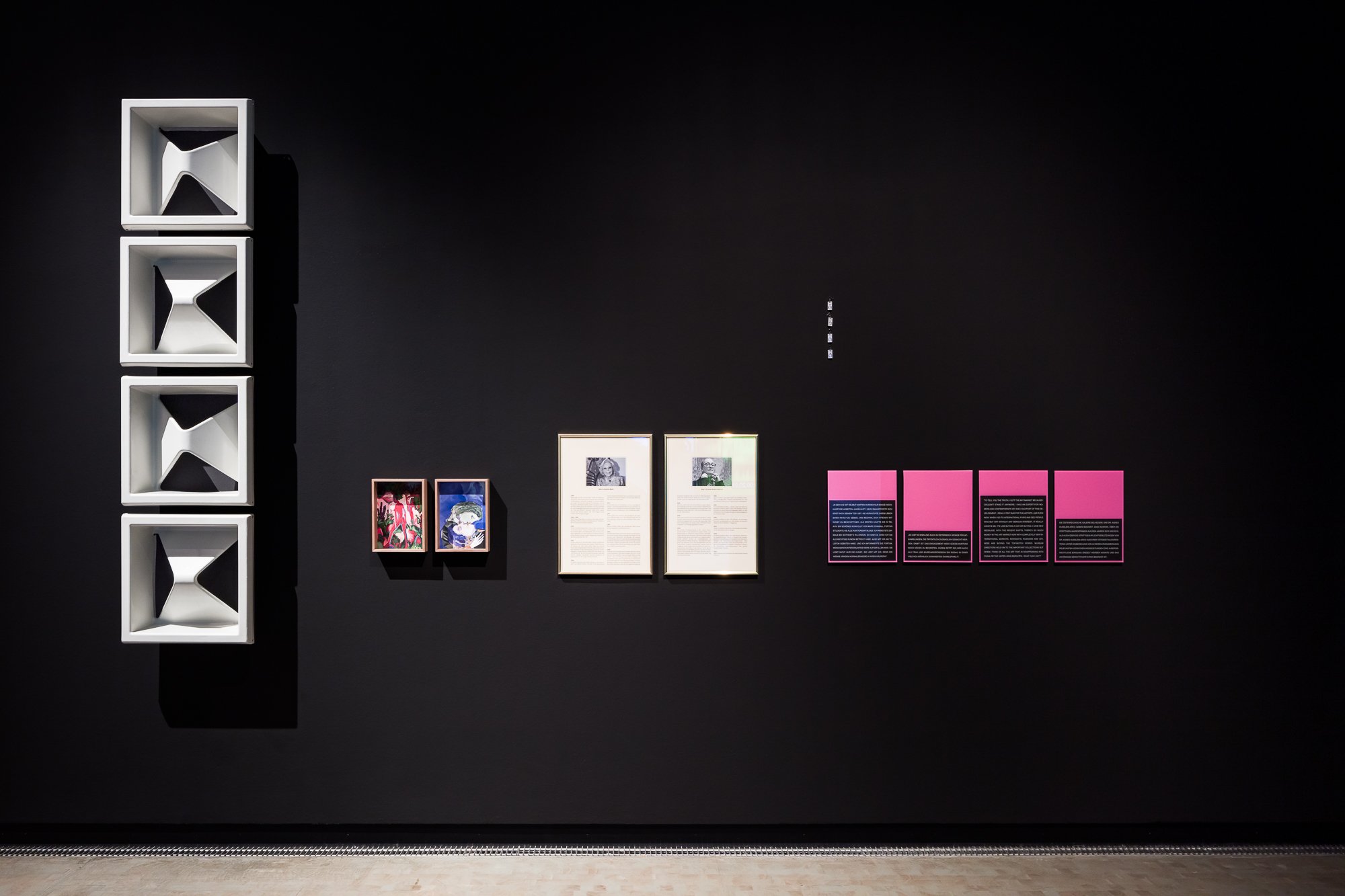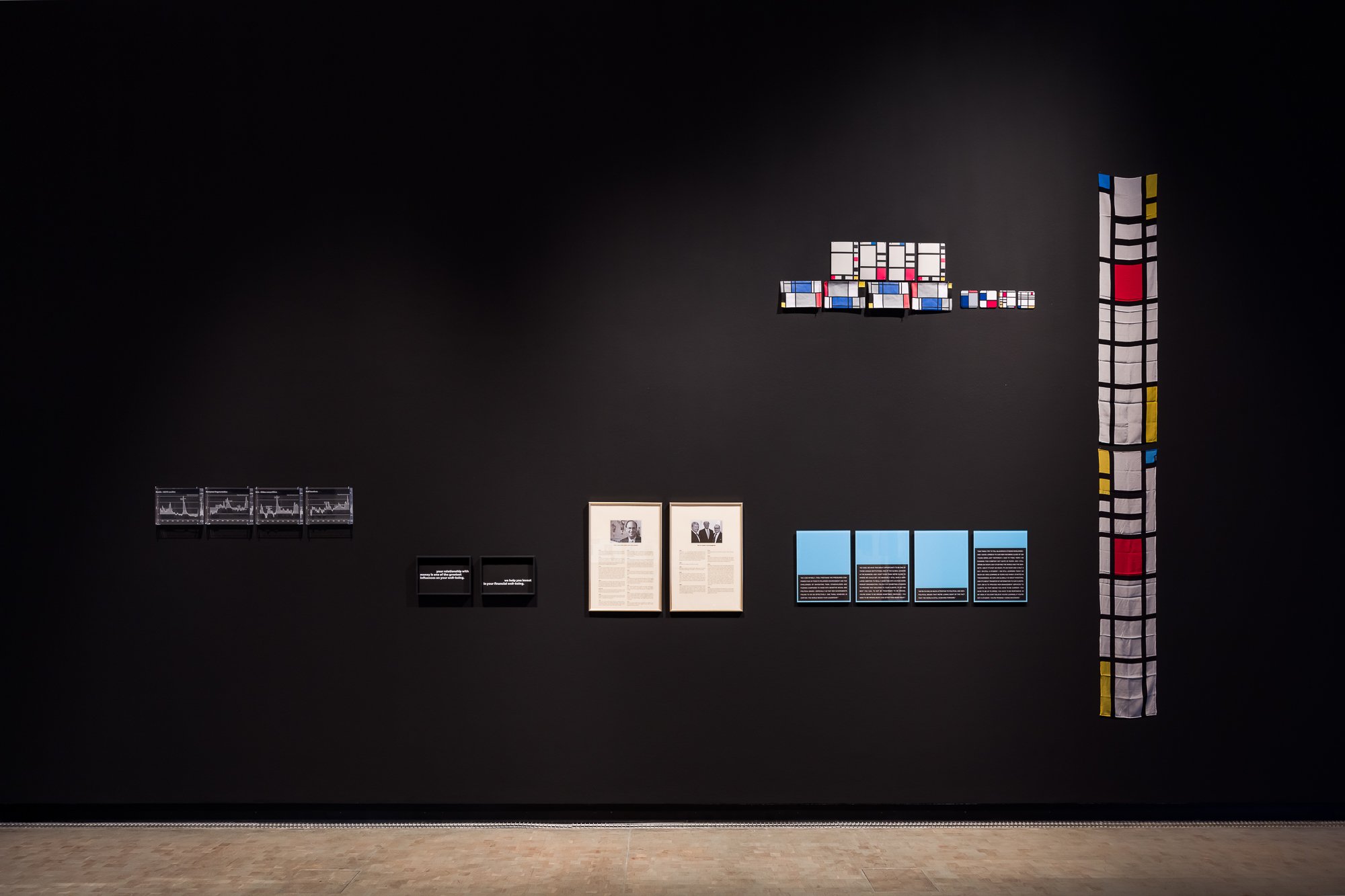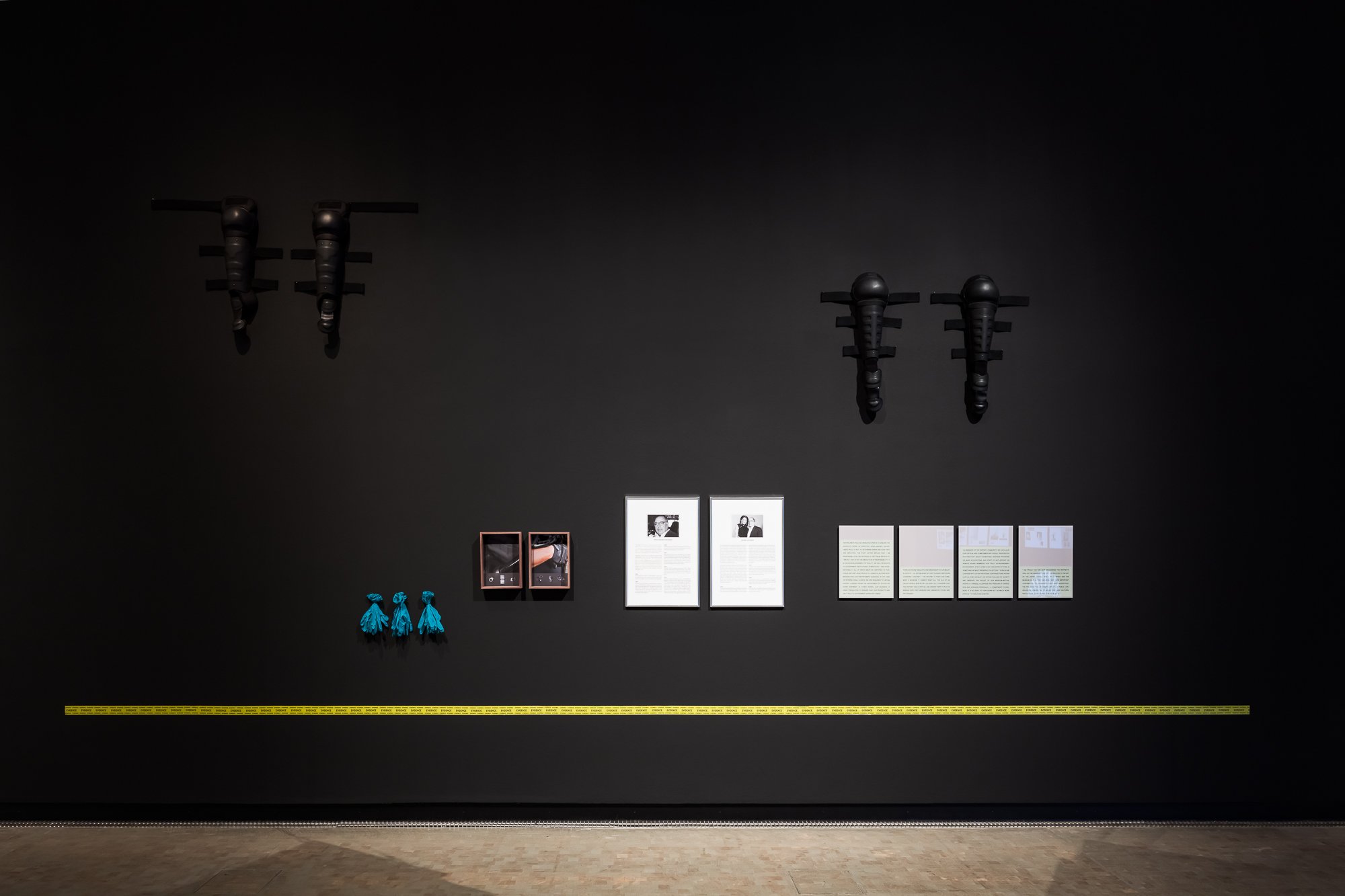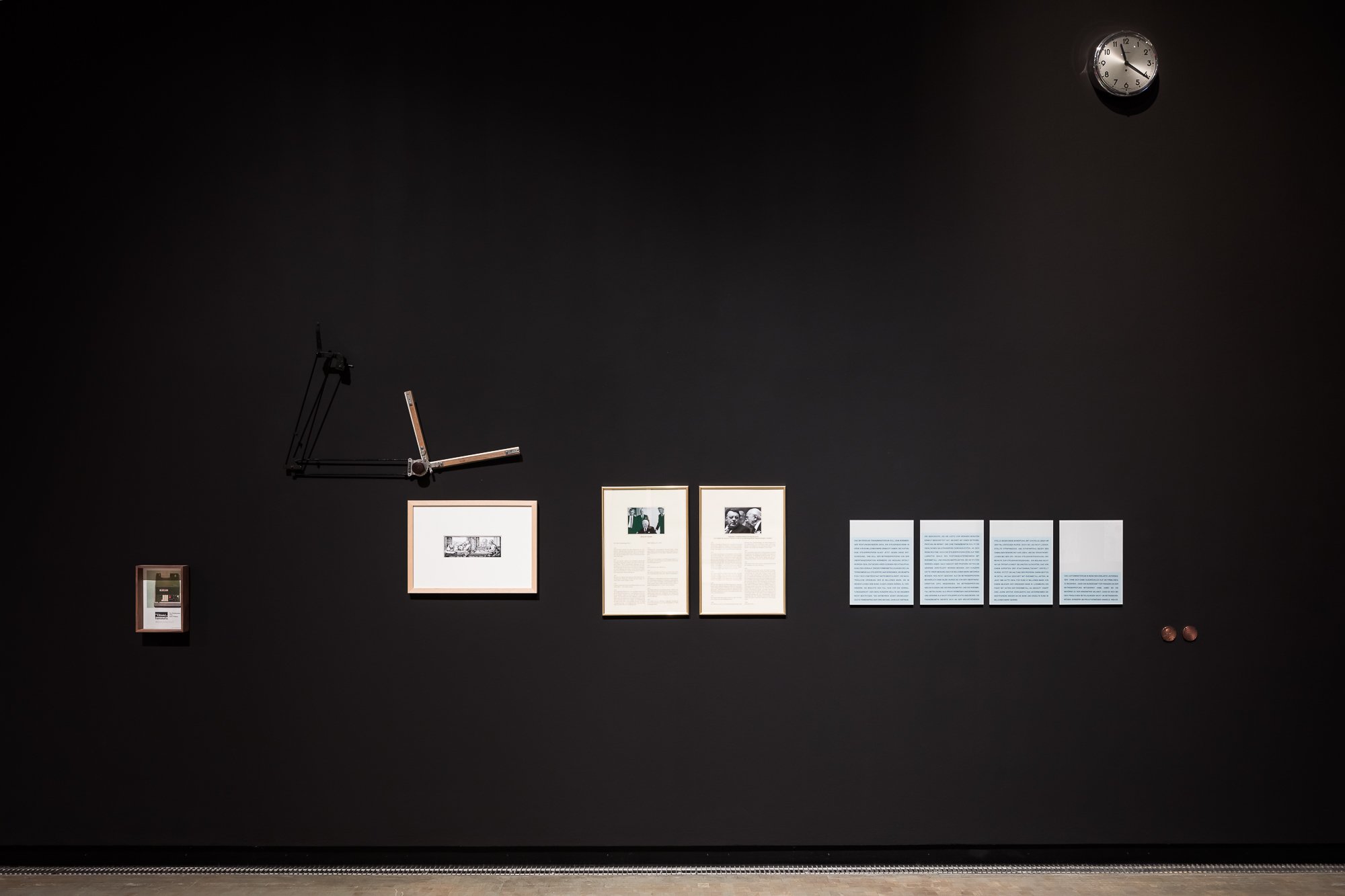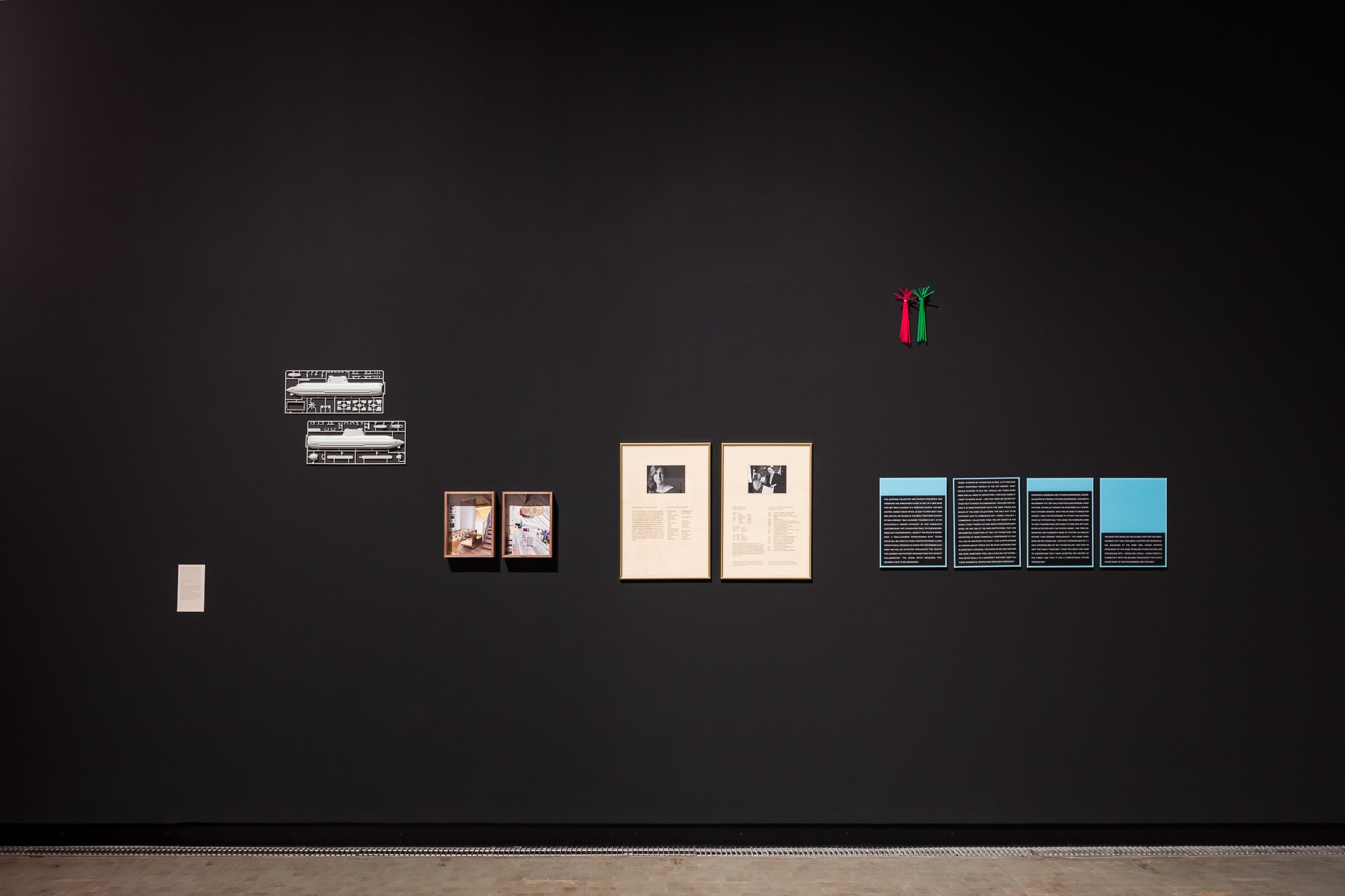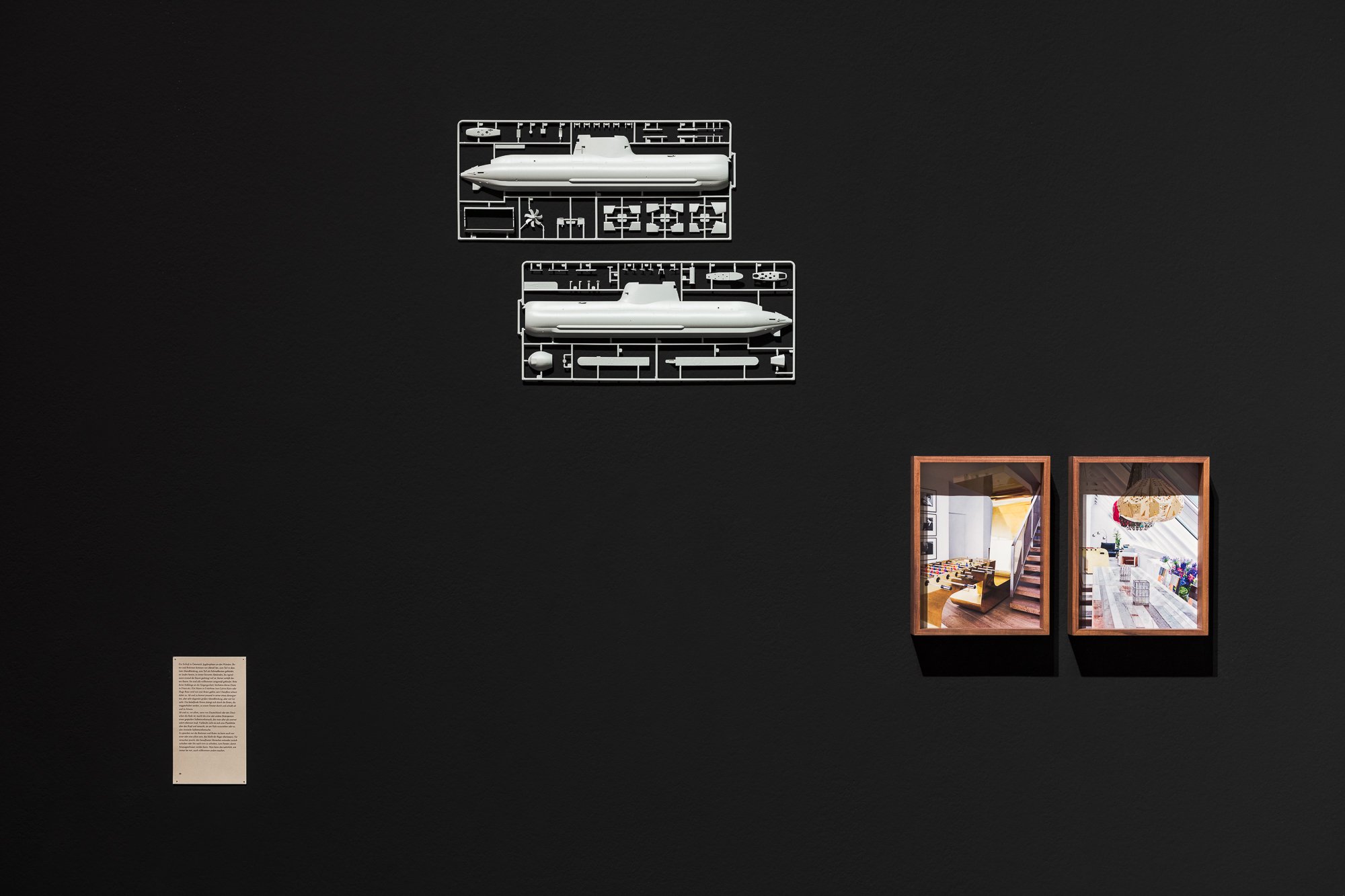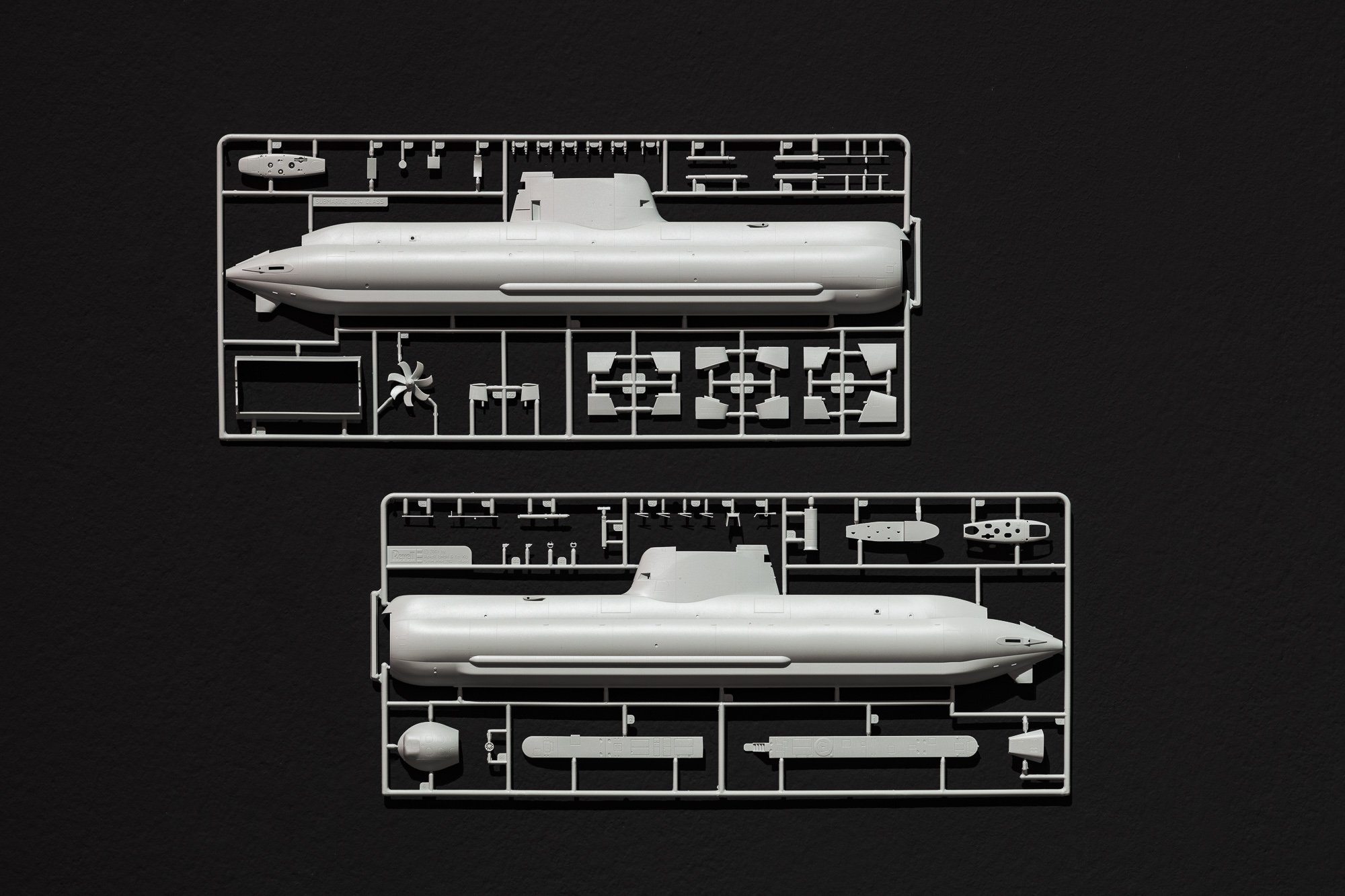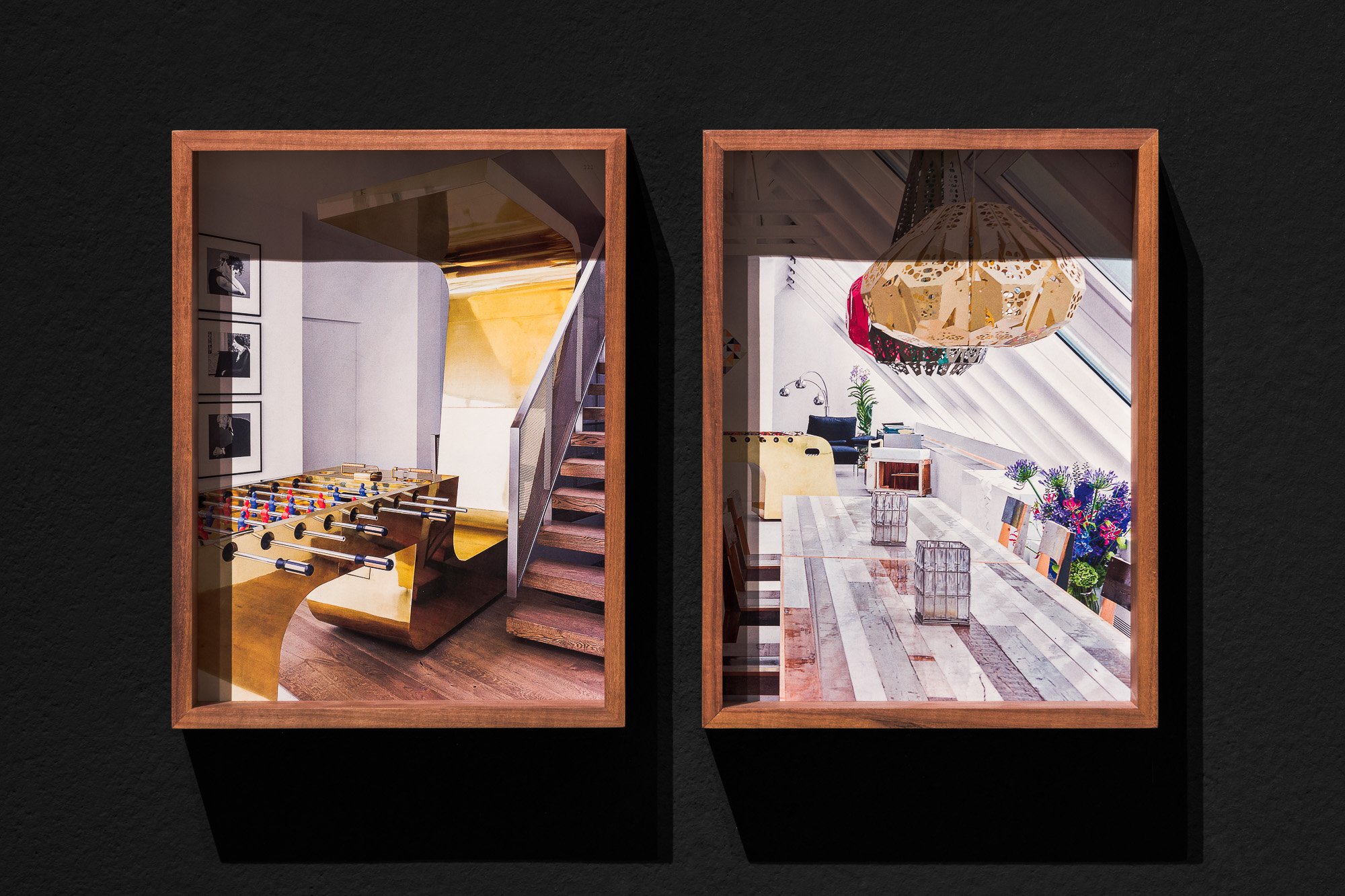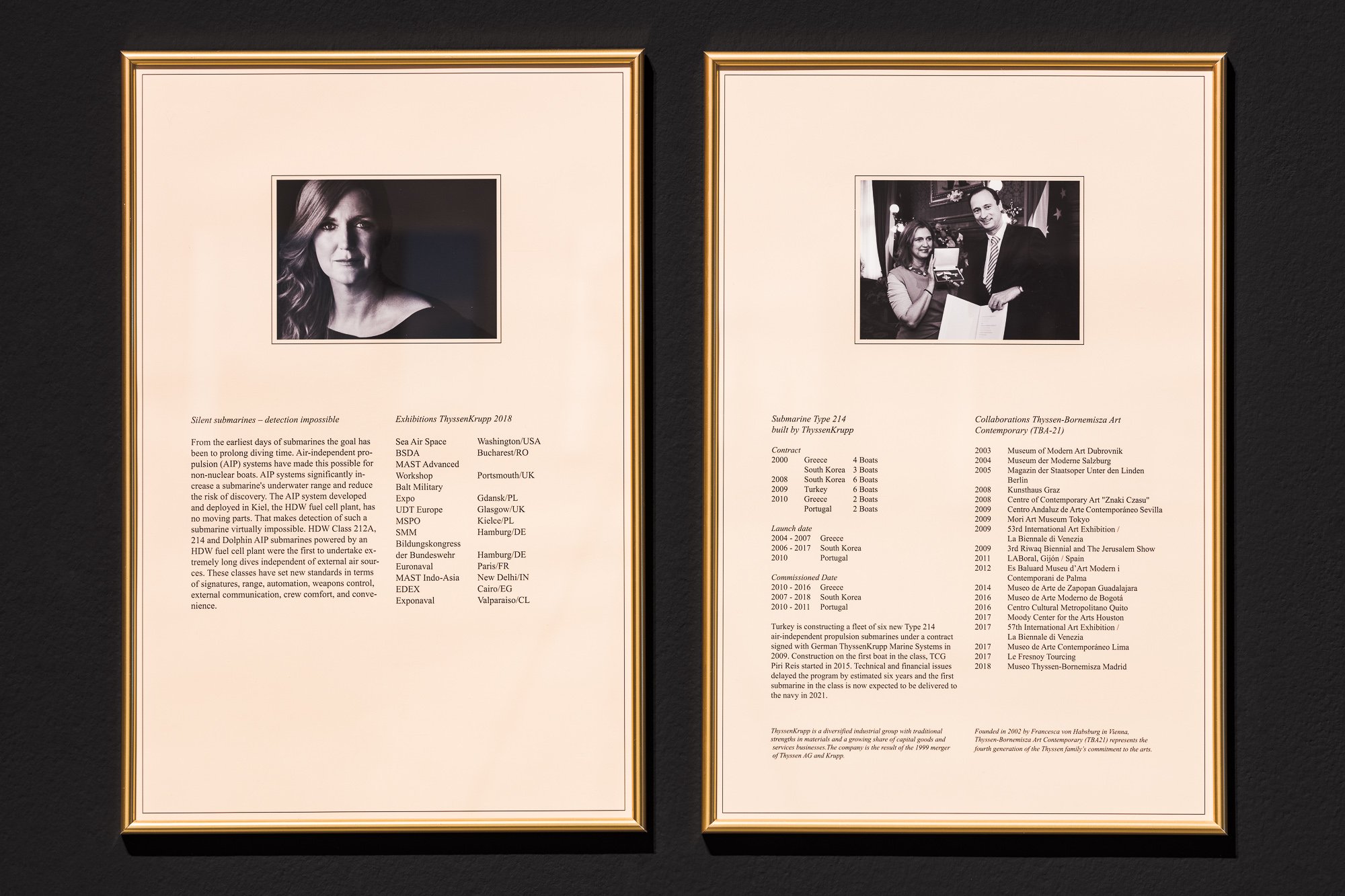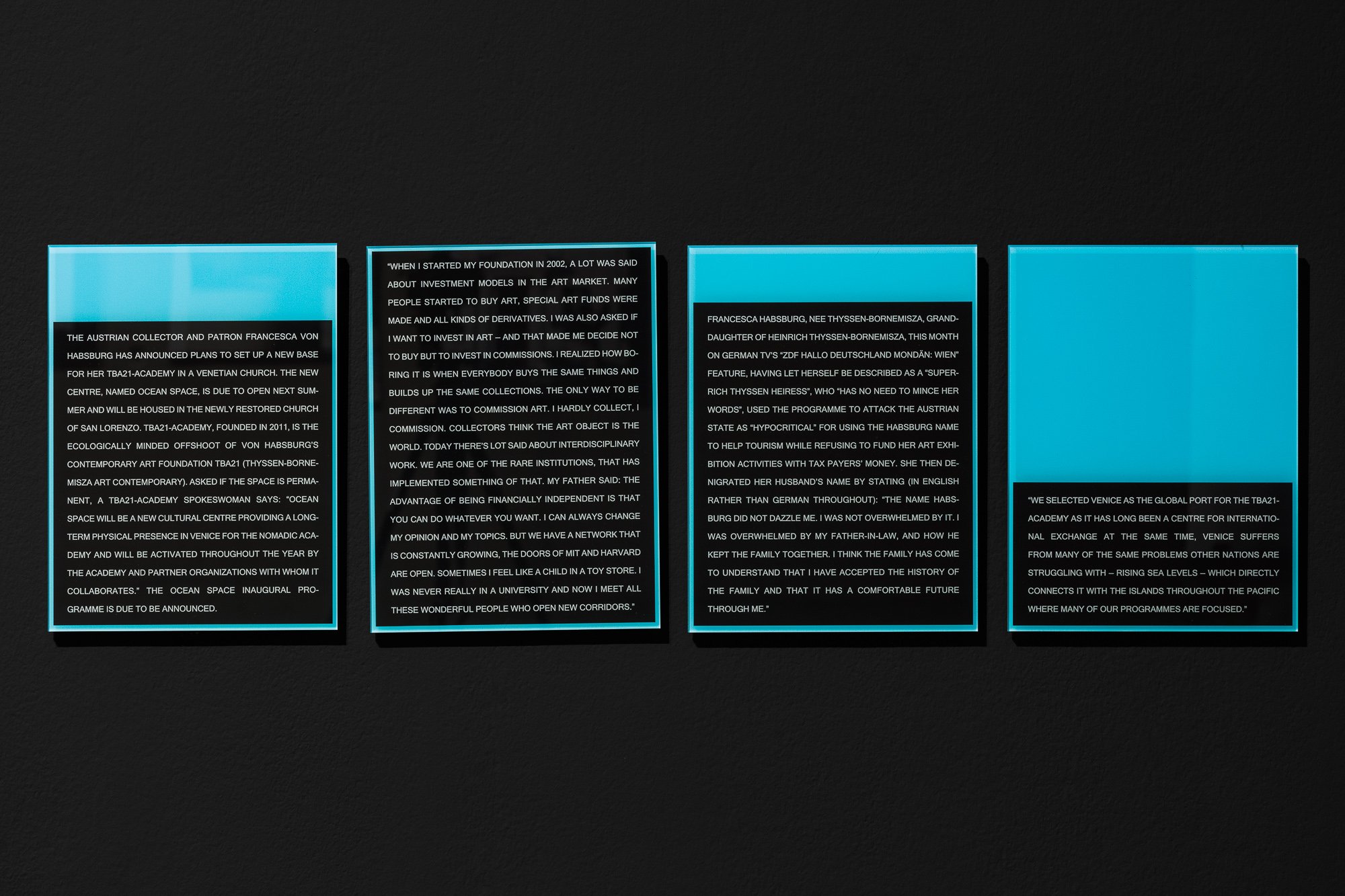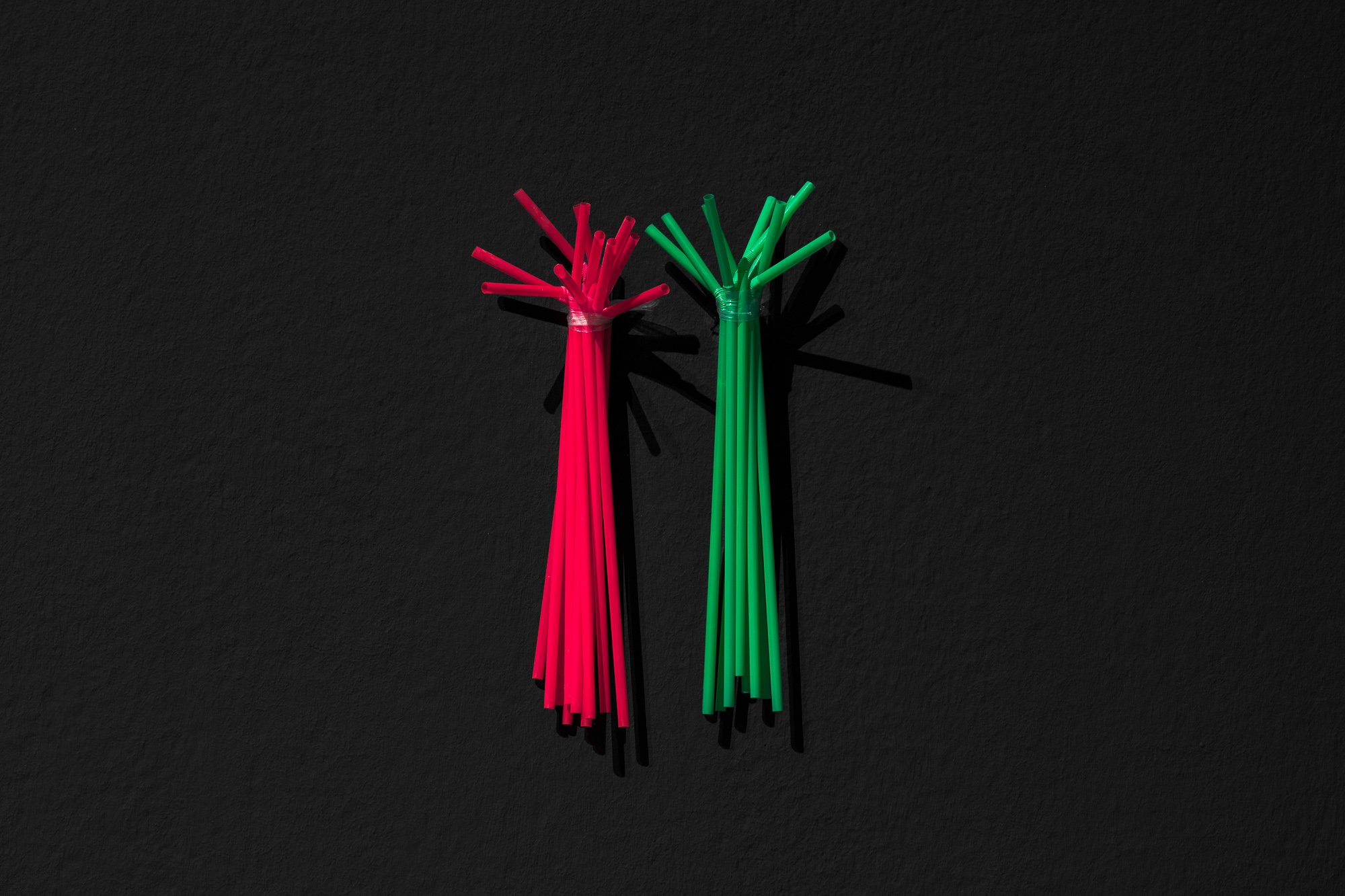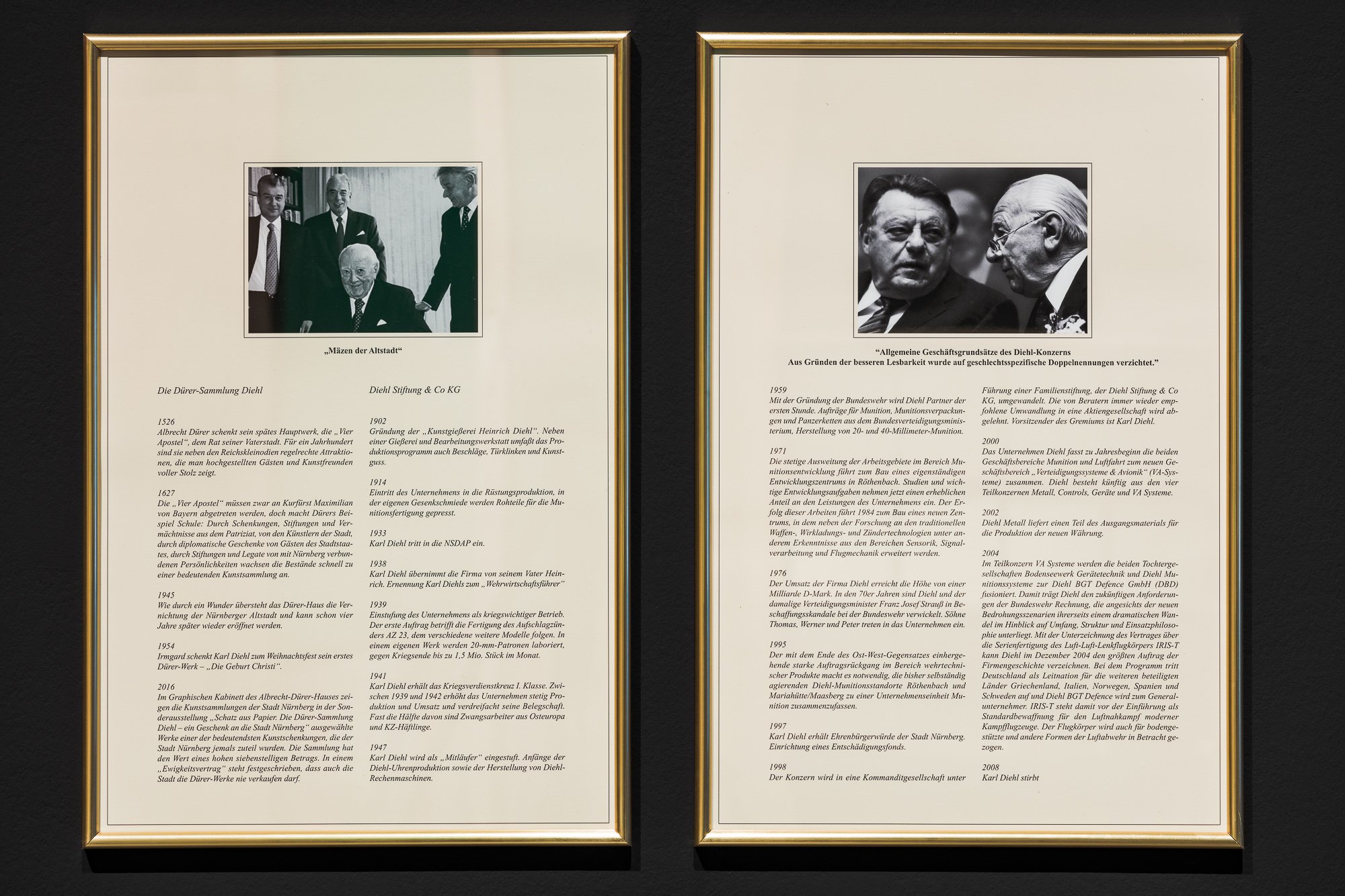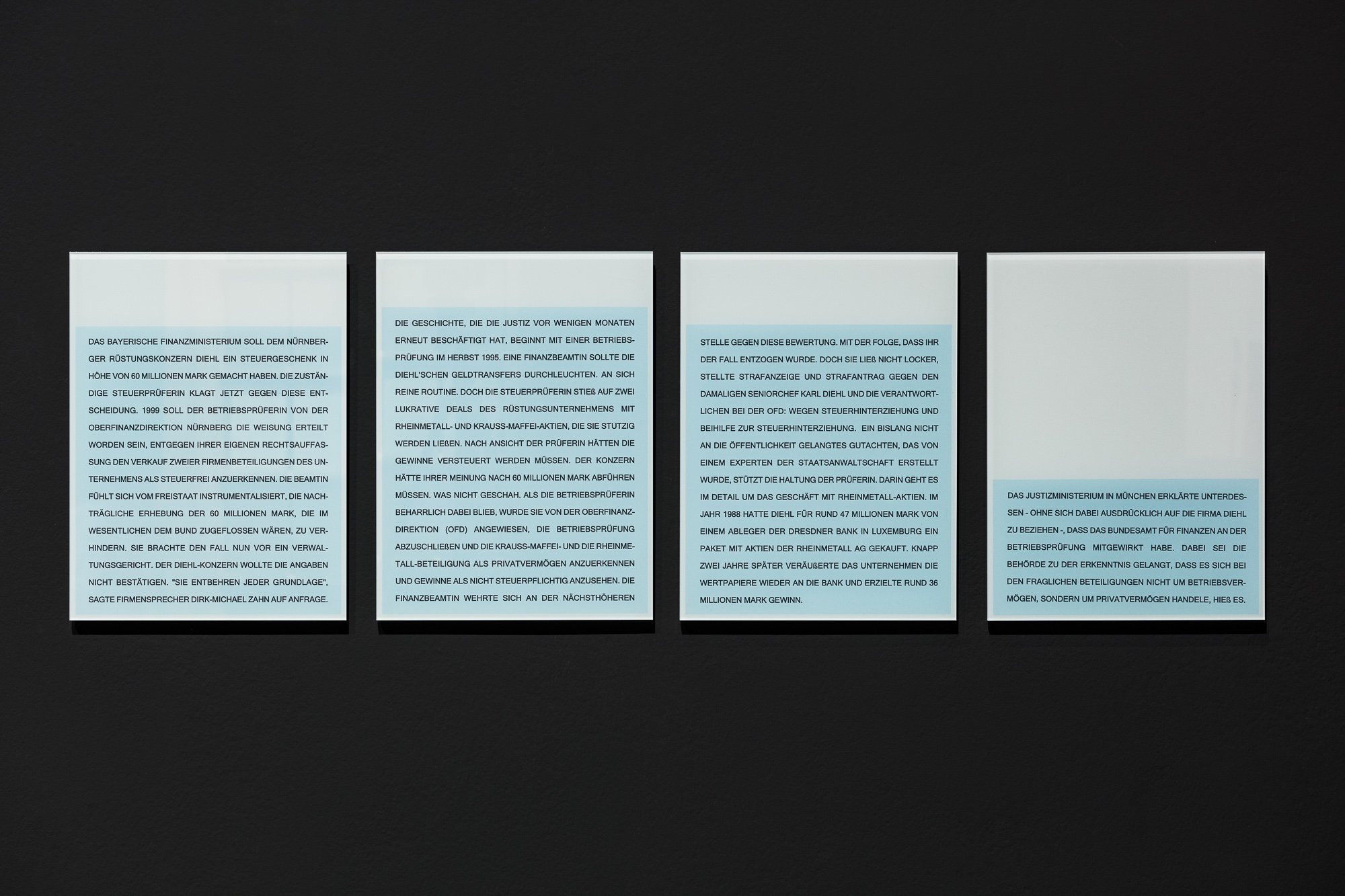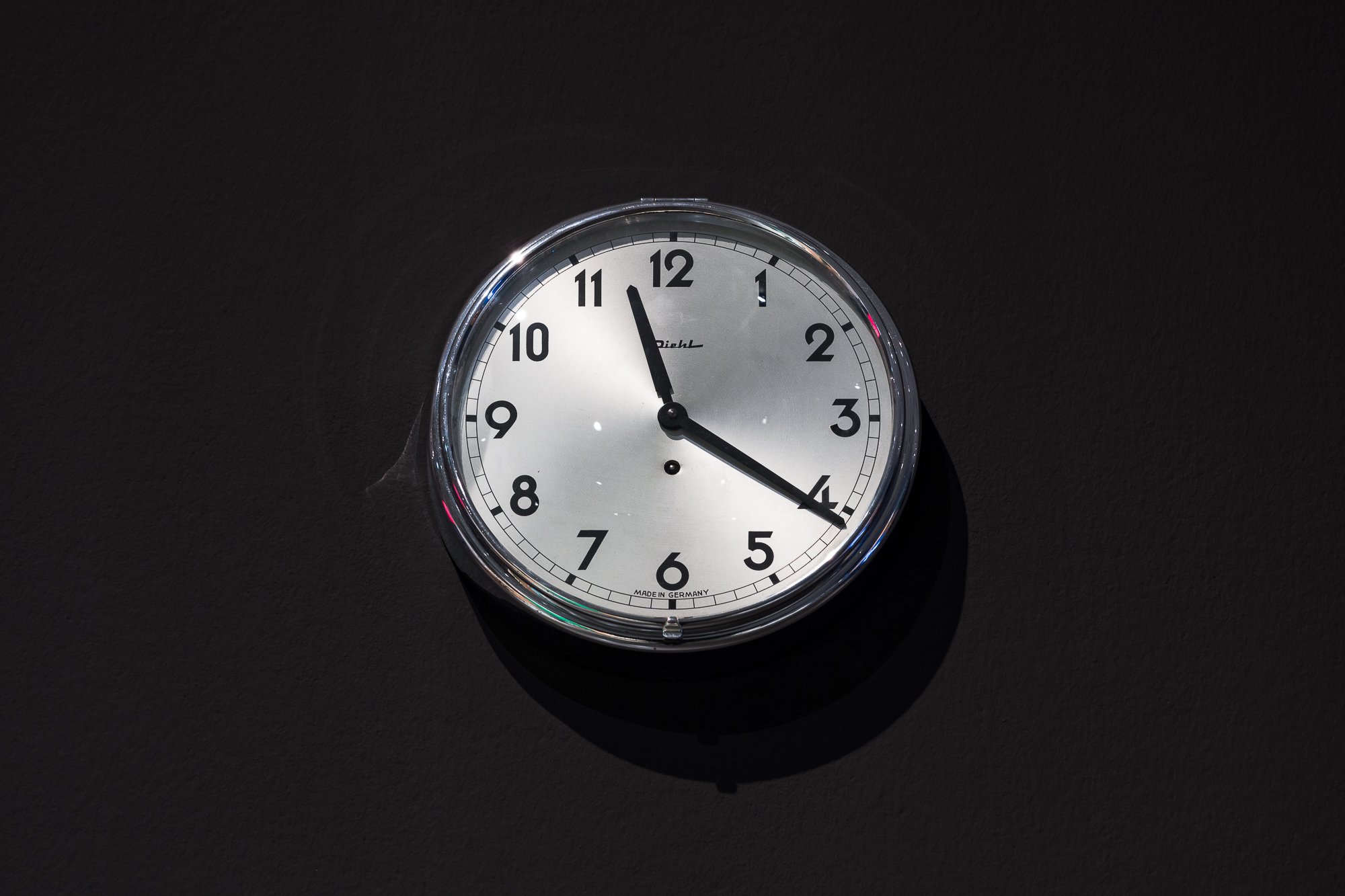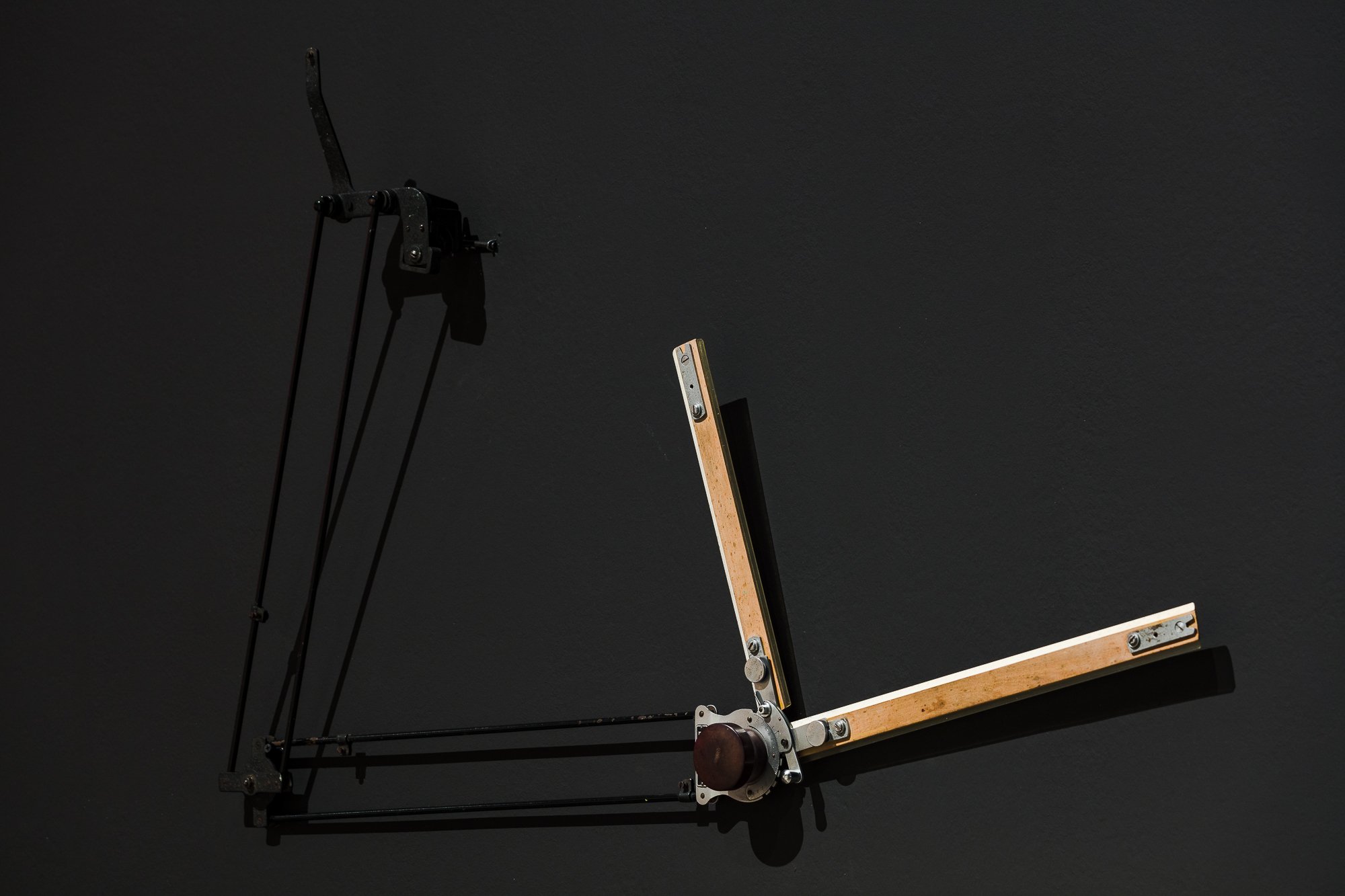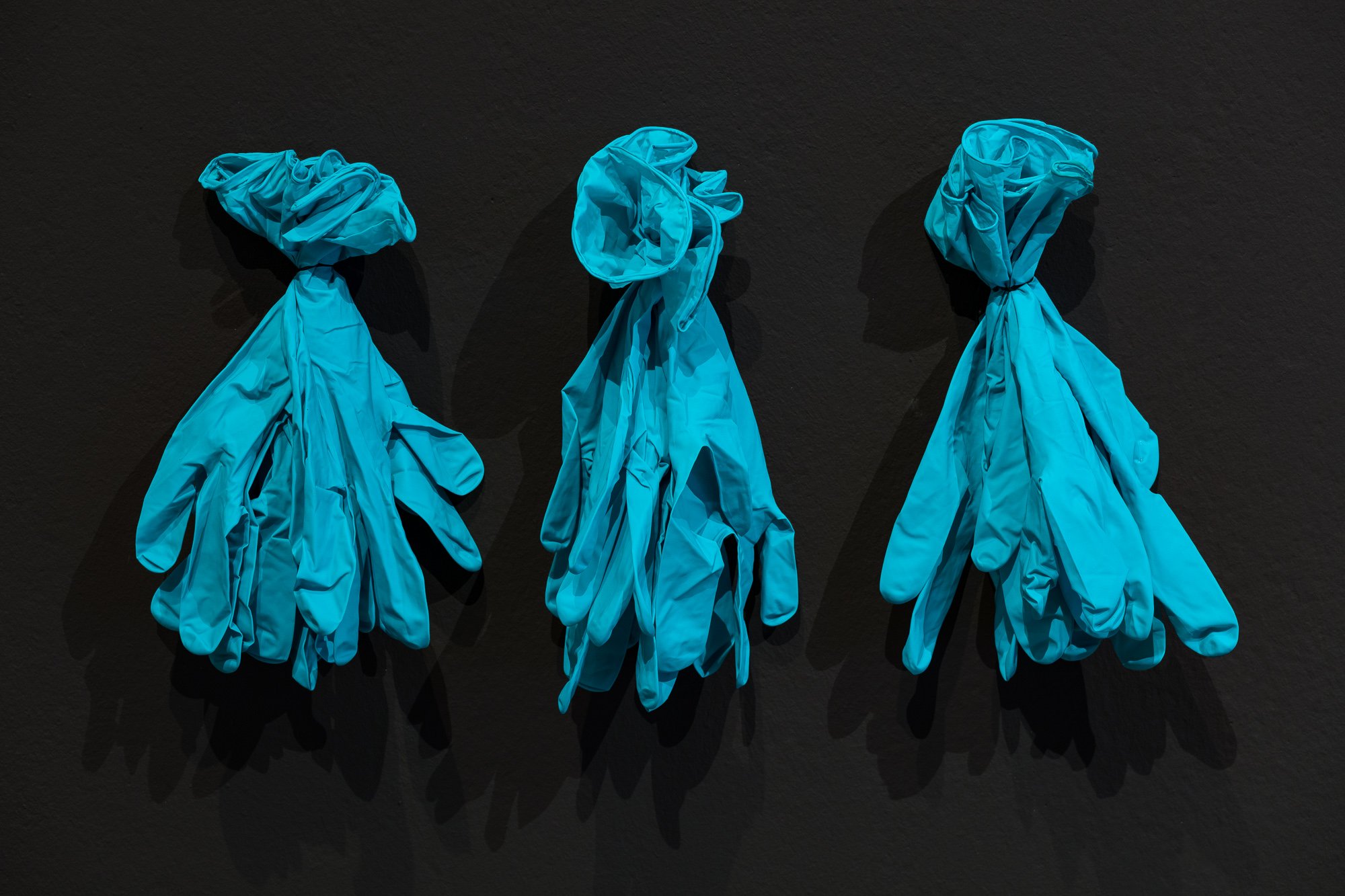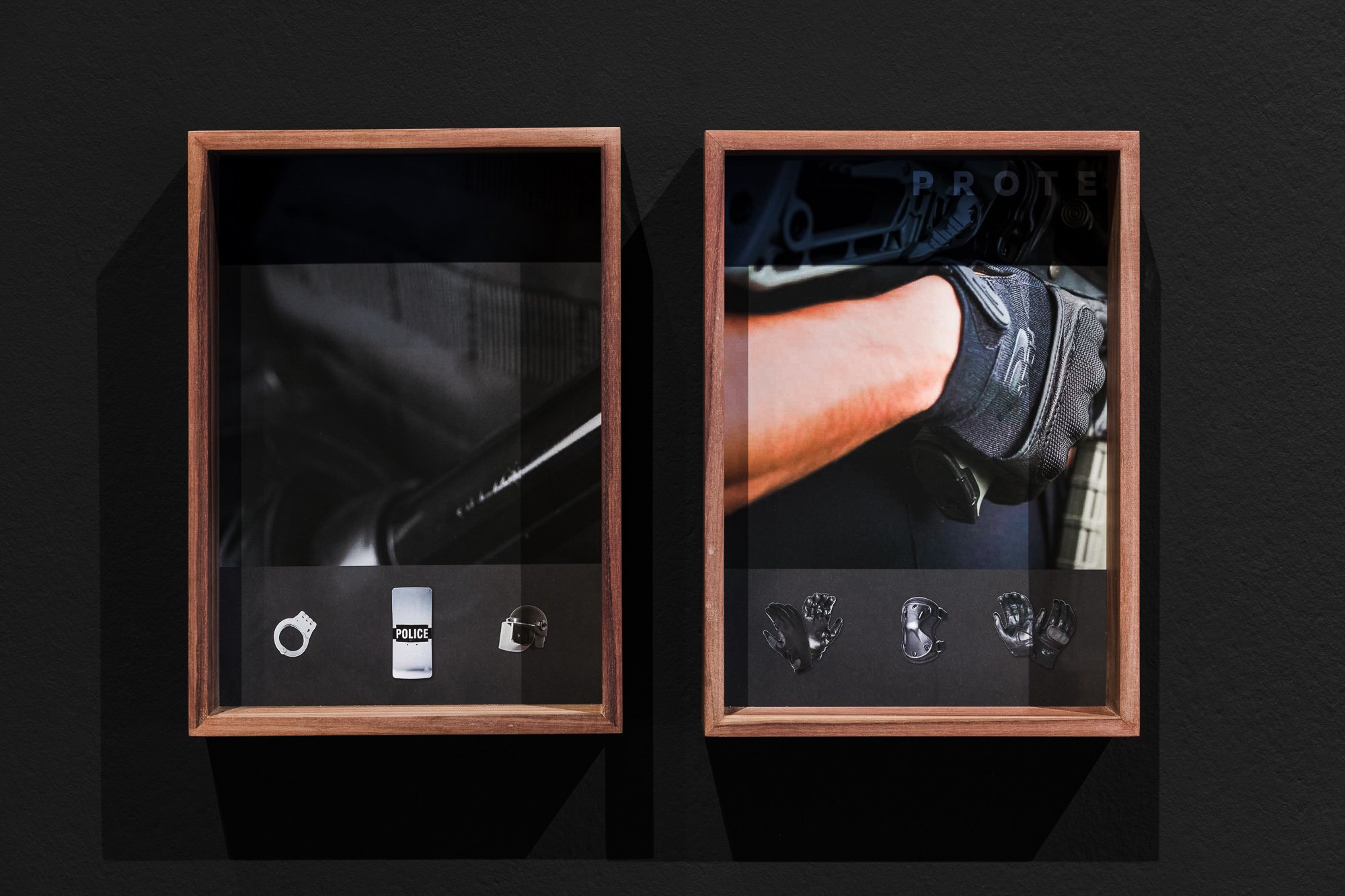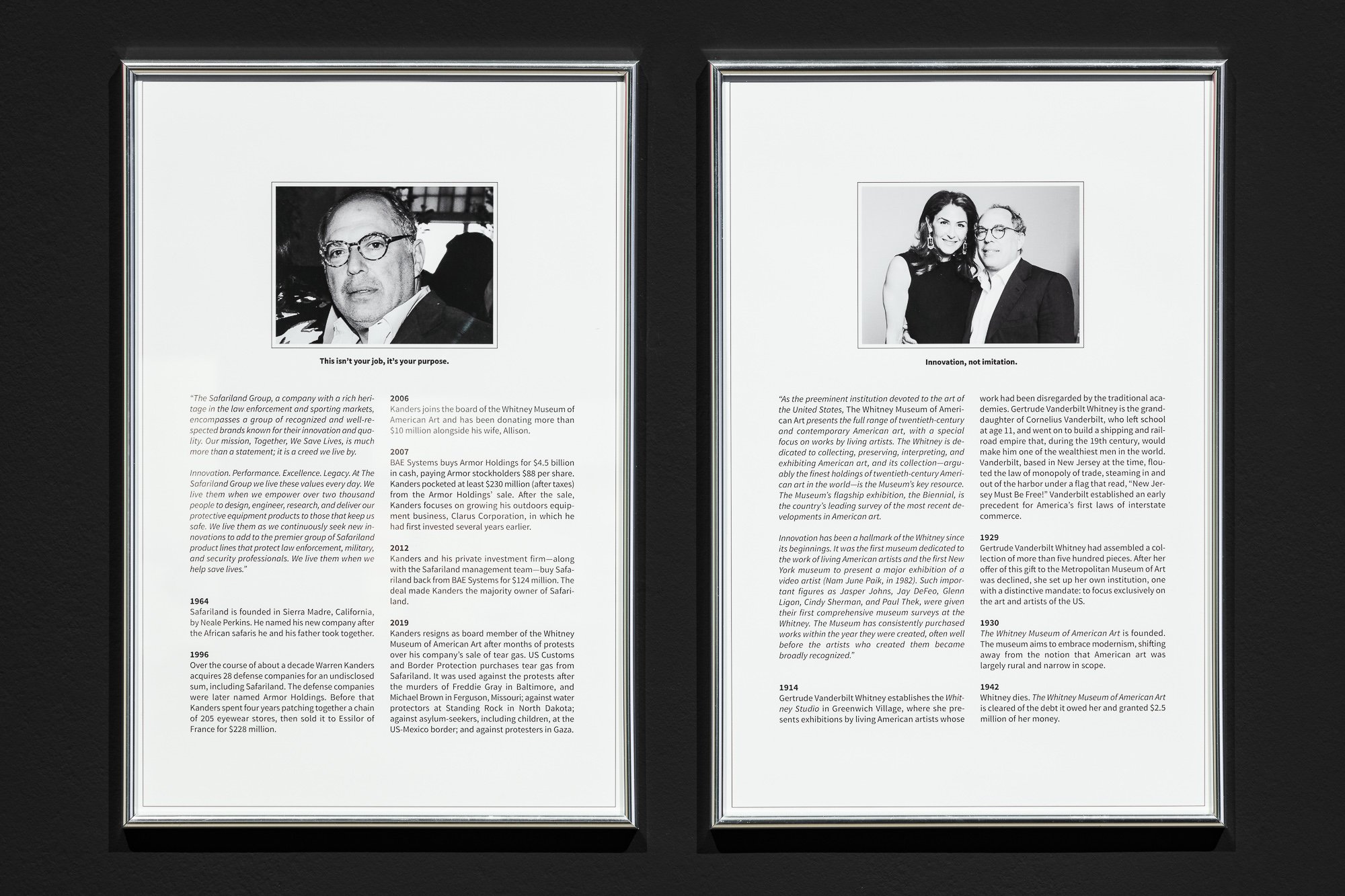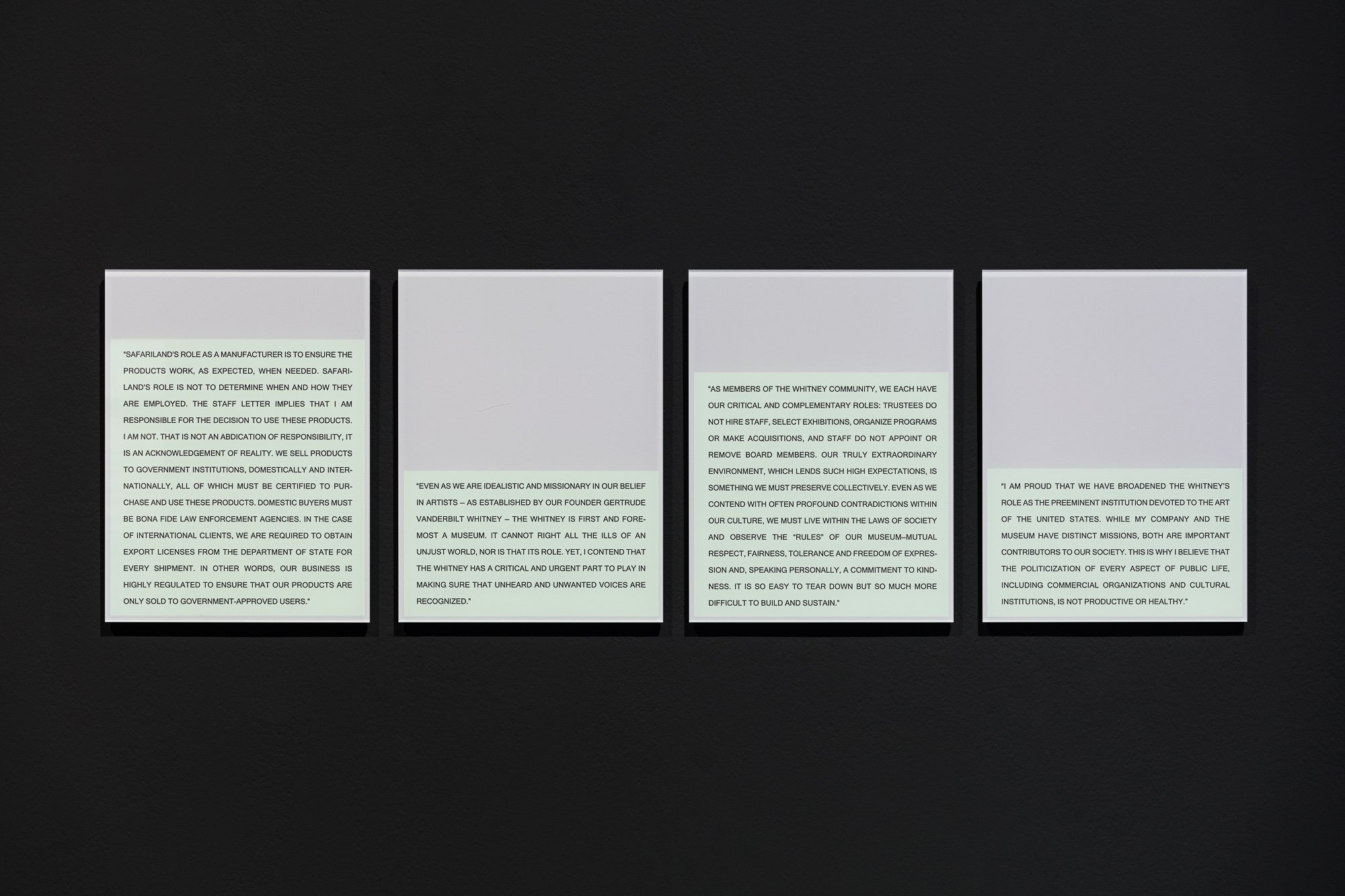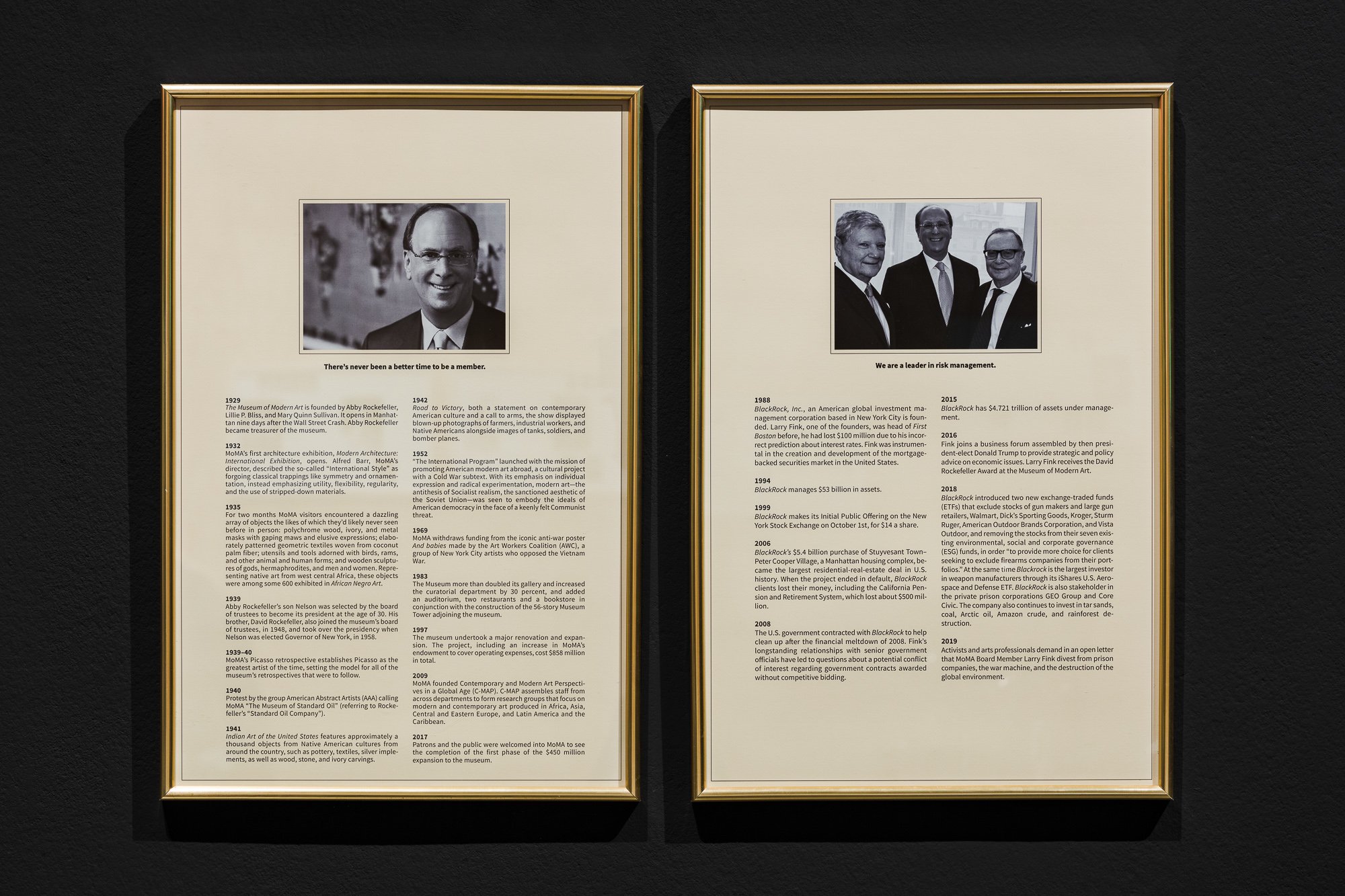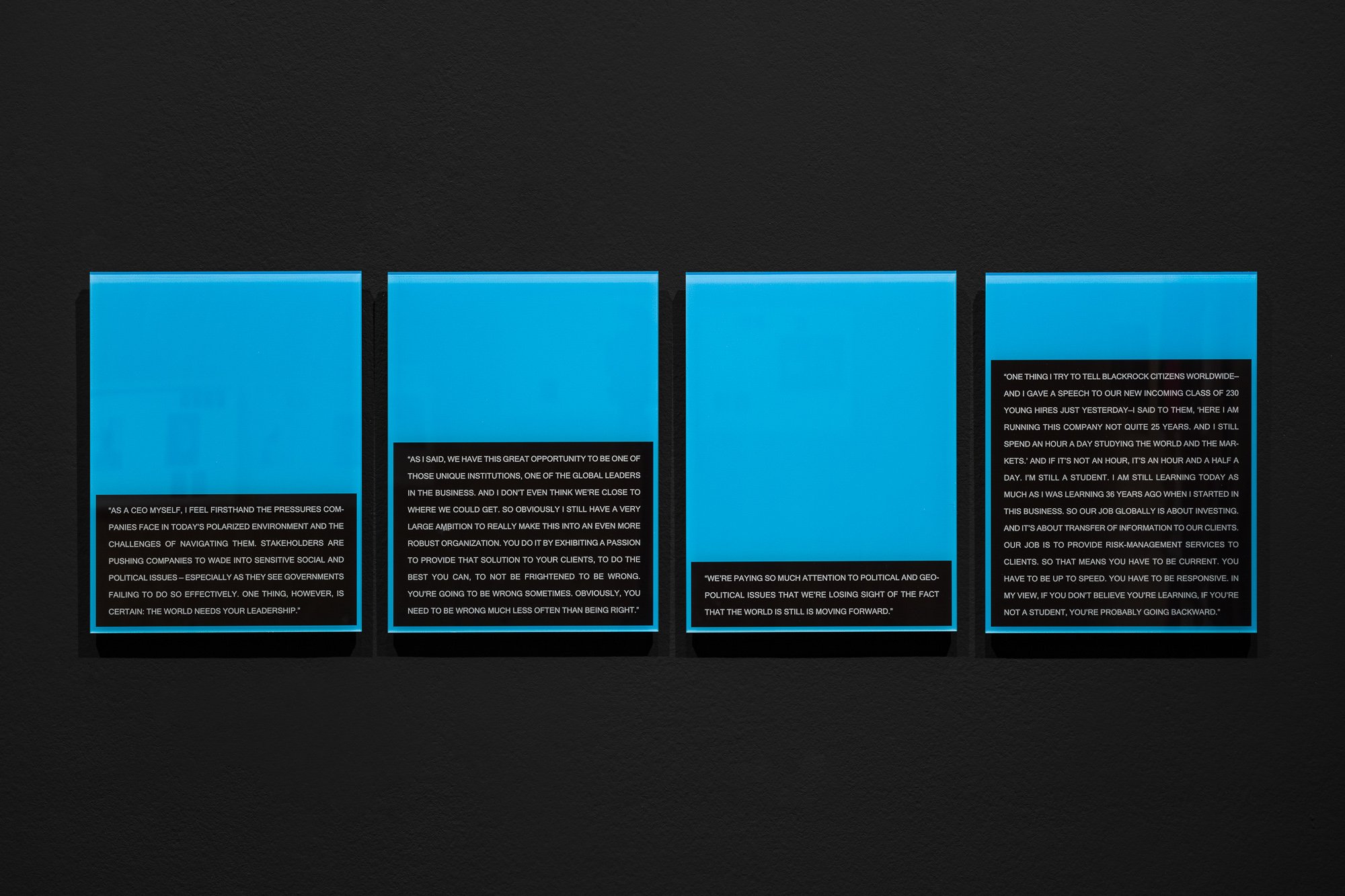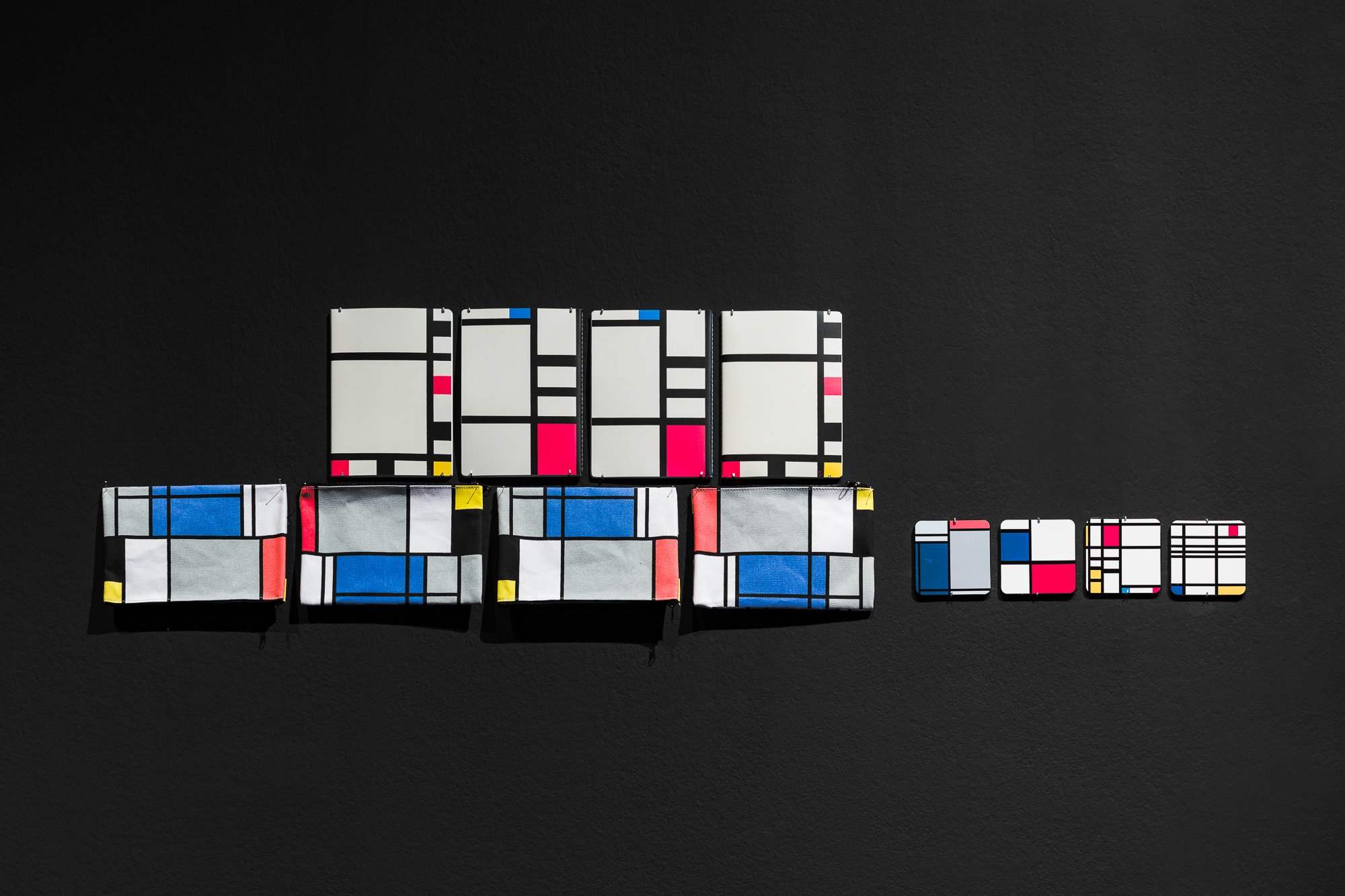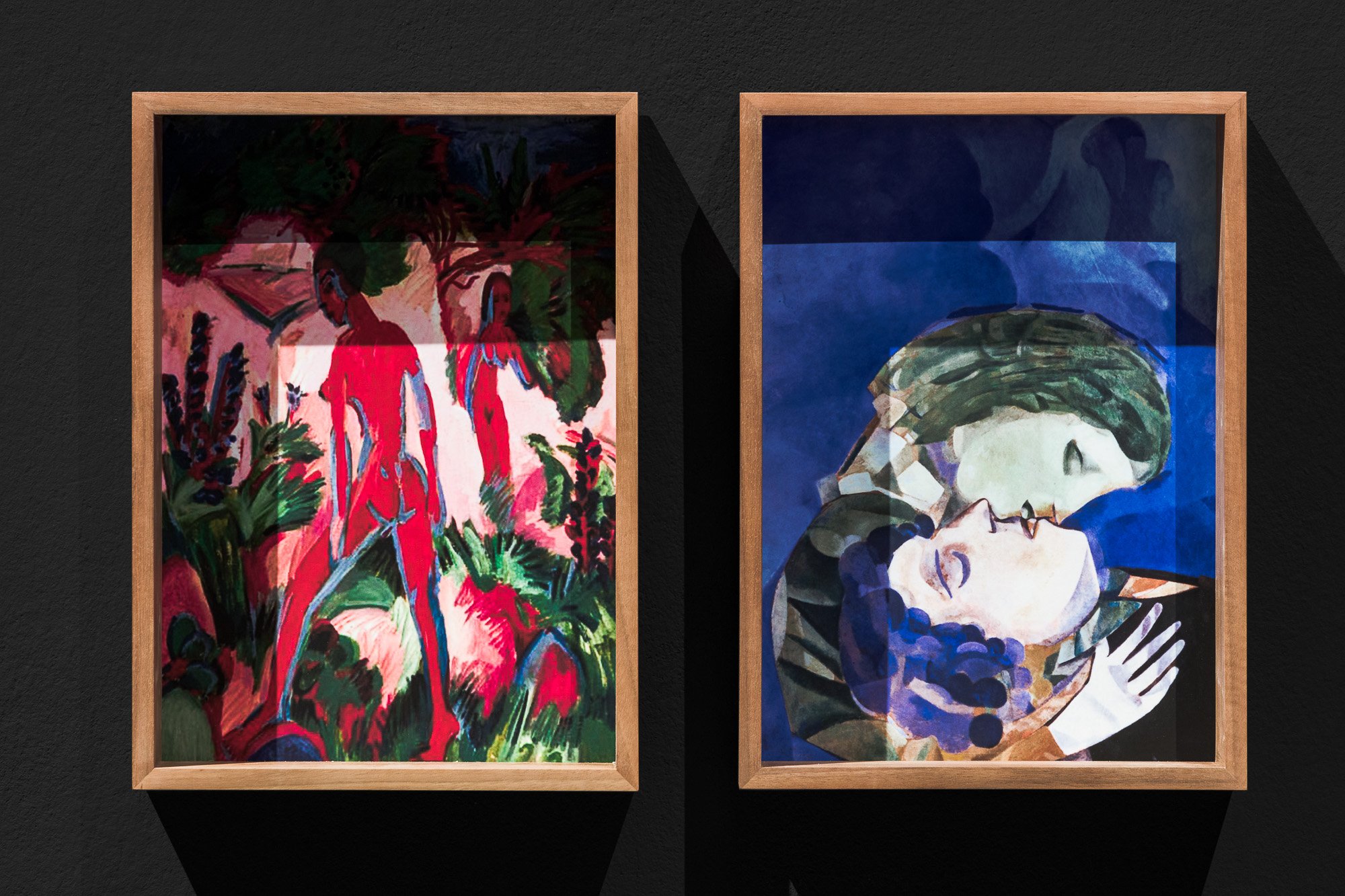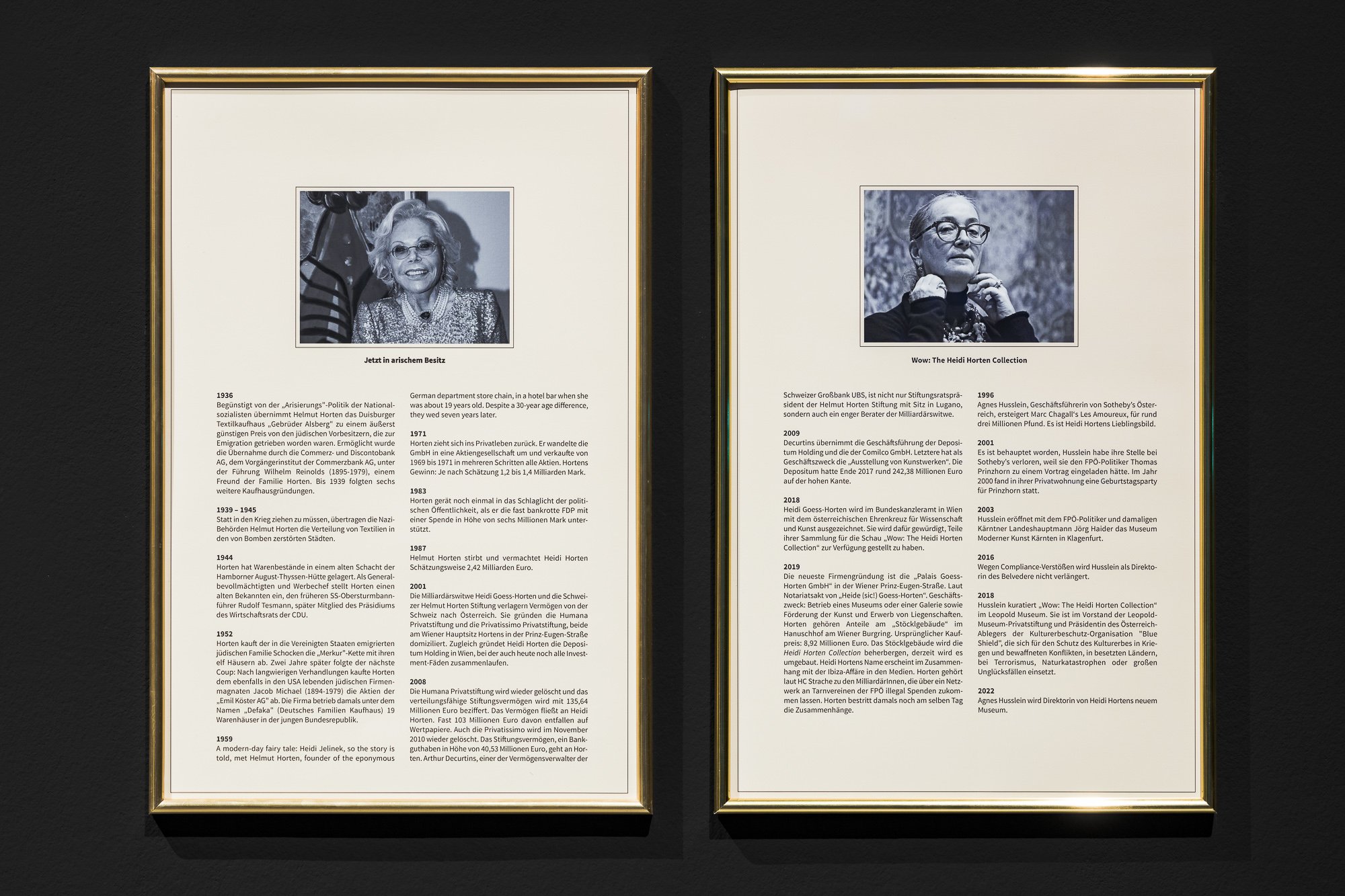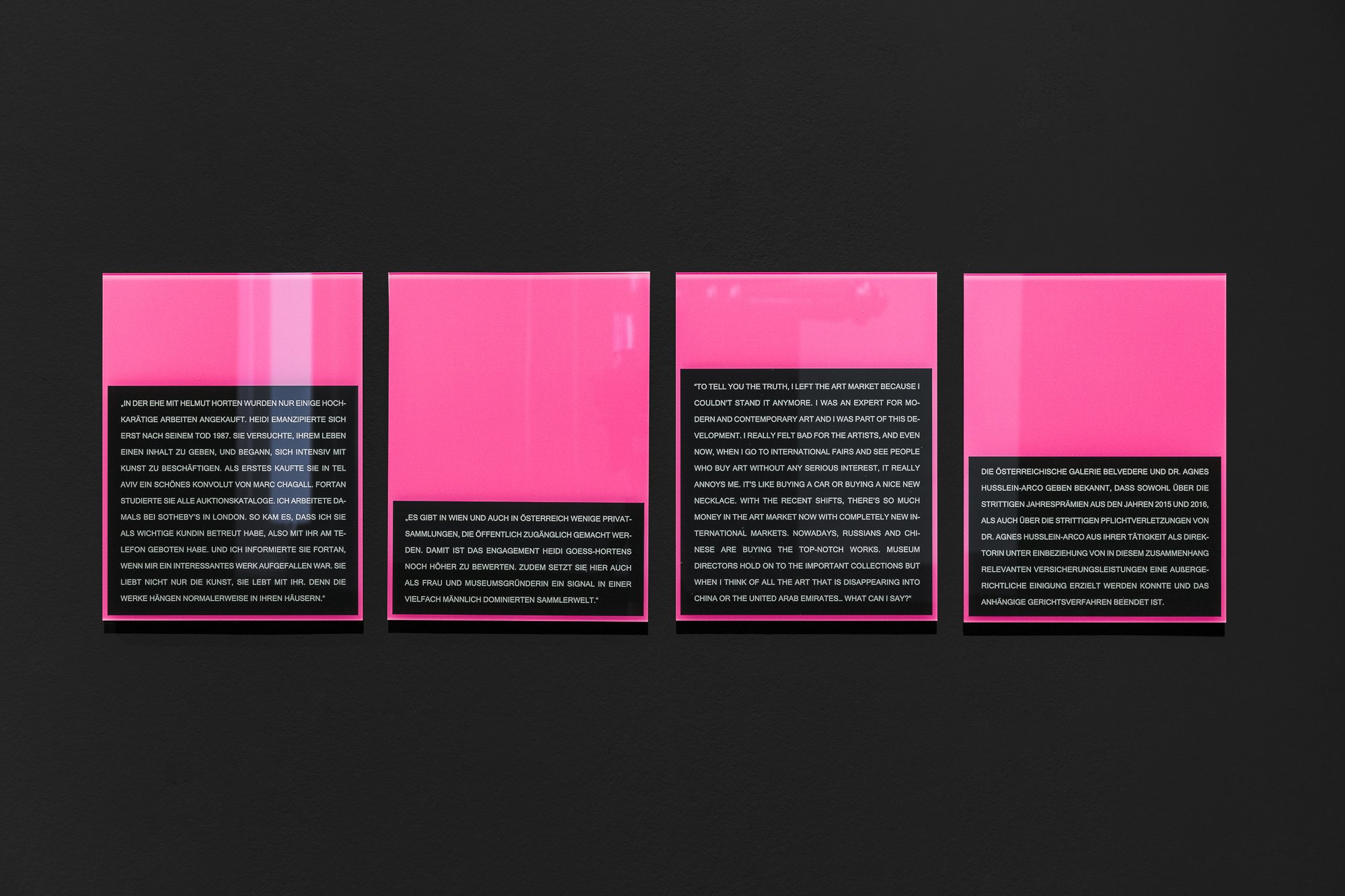Private View, 2018–2021
Work series
Ana Hoffner ex-Prvulovic*’s series Private View tackles investment in art institutions from the weapons industry, hedgefund companies, and investors of Nazi heritage. Each item from Ana Hoffner ex-Prvulovic* series is a case study of one specific and situated example of entanglement between capital and art. All items share a similar structure: two (cheap) shiny frames in the middle offer a comparative chronology of the two subjects (persons, companies, or institutions); acrylic plates feature quotes by the people involved; and finally, a selection of loosely related images and objects hang around the central items.
Private View - Silent Weapon
2 prints, framed, each 60x40; 4 prints, acrylic glass, each 30x40cm; 2 prints, framed, each 21x29; book page, plastic submarine, straws
Private View - Silent Weapon (2018) recounts and juxtaposes the rise of the contemporary art foundation and art collection TBA21 (Thyssen-Bornemisza Art Contemporary) with the simultaneous production of submarines by the German company ThyssenKrupp Marine Systems. The foundation emerged in 2002 and is a financial side project of a holding owned by Francesca Habsburg (born Thyssen-Bornemisza), who inherited the fortune built up by the Thyssen family through Thyssen AG, the parent company of ThyssenKrupp Marine Systems. Full financial transparency about the holding or the foundation is not available to the general public, but the traces of the opaque financial channels between TBA21 and ThyssenKrupp suggest a deep entanglement of war, wealth and contemporary art. "Private View - Silent Weapon" is a display that decodes the signs of this entanglement. The installation’s starting point resembles Hans Haacke’s “The Chocolate Master”: the foundation’s institutional collaborations are confronted with business data about the submarine type 214, built by ThyssenKrupp and currently sold to Turkey, Greece, Portugal and South Korea. Advertising slogans promoting the undetectability of the submarine are accompanied by the list of exhibitions by ThyssenKrupp in international military expos. Quotes from Francesca Habsburg about the newly established “Ocean Space” in Venice, as well the foundation’s engagement in climate issues are part of the installation, as well as two found images from a home interior magazine, in which Francesca Habsburg presents works from her art collection as part of her home’s interior design. Crucially, the installation includes the first page of Elfriede Jelinek’s play “Rechnitz (Der Würgeengel)”. The play is based on the massacre of Jewish forced laborers in the castle of Rechnitz, in which Margit von Batthyany (born Thyssen-Bornemisza), the aunt of Francesca Habsburg, took part.
Private View – Blue Blood
2 prints, framed, each 40 x 60 cm; 4 prints, acrylic glass, each 30 x 40 cm; 2 prints, framed, each 21 x 29 cm; Horten tiles, earrings
Private View – Blue Blood (2021) confronts two Viennese figures. Heidi Goëss-Horten is a billionaire, modern and contemporary art collector, and the widow of Helmut Horten, from whom she inherited her entire fortune. Helmut Horten was a German department store tycoon who got rich in the 1930s, buying Jewish businesses at low prices as part of the NS-Aryanization process. Heidi Goëss-Horten showed her private collection some years ago at the Leopold Museum—mainly consisting of artworks by prominent artists, from Marc Chagall to Ernst Ludwig Kirchner, which were stigmatized by the Nazi regime as entartete Kunst—and is currently planning to open her own private museum in Vienna. Alongside her, the work features Agnes Husslein-Arco, former head of the Sotheby’s auction house branch in Austria and Eastern Europe and former head of the Vienna Belvedere. Husslein-Arco—who is well-known for her proximity to (extreme) right-wing politicians, as well as for the court proceedings around her disputed breaches of duty as head of the Belvedere—is a longtime friend of Heidi Goëss-Horten, whom she advised in the 1990s. She is also the presumed new director of the Heidi Horten museum to come.
Private View – Modern Members
2 prints, framed, each 40 x 60 cm; 4 prints, acrylic glass, each 30 x 40 cm; 2 prints, framed, each 29 x 21 cm; MoMA shop products, engraved acrylic blocks
Larry Fink, a board member of the Museum of Modern Art (MoMA) in New York, is the object of inquiry of Private View – Modern Members (2021). CEO of BlackRock, an American multinational investment management corporation, Larry Fink has also practiced investment consulting for several governments, relentlessly working toward the privatization and transformation of pension systems in investment funds. The artist* draws a parallel between the creation, exhibition politics, and extension of the MoMA and the expansion and diversification of the business activities of Larry Fink. The MoMA was established in 1929 by Abby Aldrich Rockefeller, wife of John D. Rockefeller Jr., in a wave of American institutions (including New York’s Whitney Museum of American Art) that owed their creation to wealthy patrons, even if supported by city and federal governments. The creation of such institutions marked a shift from reliance on government funding to reliance on funding from ticket and membership sales, corporate sponsorships, and private donors. As institutions increasingly rely upon private funders, they also begin to accept significant funding from donors who do not align with the interests of artists or with basic ethics; and so, it has become less clear whether institutions are really for the “public”. Alongside the two central chronologies and the heavily neoliberal quotes by Larry Fink, the artist* chose to engrave into thick, heavy plexiglass plates the charts of some shares related to BlackRock—showing their extreme rentability (and volatility). Also, MoMA merchandise, based on the appropriation and repetition ad infinitum of Piet Mondrian’s abstract geometric patterns, complete the selection of market products, material and immaterial, funny and dreadful, all financing one of the most famous museums in the world.
Private View – Big Safari
2 prints, framed, each 40 x 60 cm; 4 prints, acrylic glass, each 30 x 40 cm; 2 reprints, framed, each 21 x 29 cm; green plastic gloves, protection gear
Private View – Big Safari (2021) focuses on Warren Kanders, former vice-chairman of the Whitney Museum of American Art in New York and CEO of Safariland, a company manufacturing military and police equipment. Warren Kanders stepped down as vice-chairman of the Whitney in 2019 after protests (and an occupation of the Whitney’s lobby) over his company’s sale of tear gas—tear gas used against protesters after the murders of Freddie Gray in Baltimore, Maryland, and Michael Brown in Ferguson, Missouri. The protesters focused their attention on the trusteeship of patrons with political positions differing drastically from the institutions they contribute funding to, as well as on the necessity to cede board positions to artists within the communities in which the museum exists. The controversy surrounding Warren Kanders reveals the separation between public interests and the structure of the institution. Ana Hoffner ex-Prvulovic*, with her* installation—again, based on the same structure as the other items of the series: comparative chronologies framed in silver, quotes in capital letters on colored paper and underneath a plexiglass plate, anti-riot police protectors fixed on the wall— visualizes it. Founded in 1931 by sculptor and patron Gertrude Vanderbilt Whitney, from whom the Metropolitan Museum of Art in New York had turned down a proposal to donate American art she had collected in previous years, the Whitney is bound to a foundational nationalistic aspiration and to figures of (right-wing) neoliberalism, to which Warren Kanders perfectly belongs. The Whitney is part of a larger group of art institutions targeted for accepting “dirty money”.
Private View – Special Gift
2 prints, framed, each 40 x 60 cm; 1 print, framed, 40 x 57 cm; 4 prints, acrylic glass, each 30 x 40 cm; found images, framed, each 21 x 29 cm; wall clock, angle meter, 2 coins
Private View – Special Gift (2019) focuses on Karl Diehl and the Diehl Foundation. The weapons producer was a collector of Albrecht Dürer’s etchings. After Diehl’s death, his collection, worth several million, was given to the city of Nuremberg as a present. The history of the company, especially its involvement in World War II as a German Nazi weapons manufacturer, is juxtaposed with the history of the original art gifts given to the collections in Nuremberg. The Diehl Foundation was founded in 1902 and has remained a patriarchal family business until today. The company started to produce watches and calculating machines in the postwar period, thus infiltrating private households while simultaneously investing in new military technology, especially ammunition and aircraft defense. Because they delivered weapons directly to the German state, the Diehl Foundation has been in close contact with politicians such as Franz Josef Strauss. The installation also consists of quotes from a report about the company’s tax fraud in which the Bavarian state was involved. Artifacts such as a commemoration coin of Karl Diehl, a Diehl wall clock, and a found image of a calculating machine are placed next to a copy of Albrecht Dürer’s Draughtsman Making a Perspective Drawing of a Reclining Woman.
Text by Anne Faucheret

